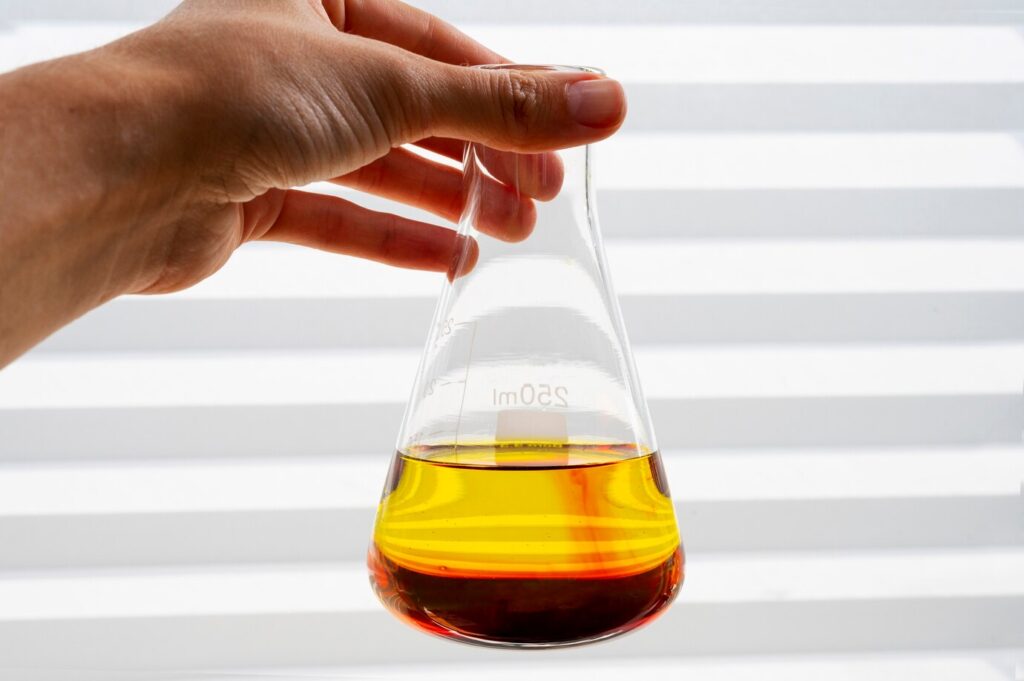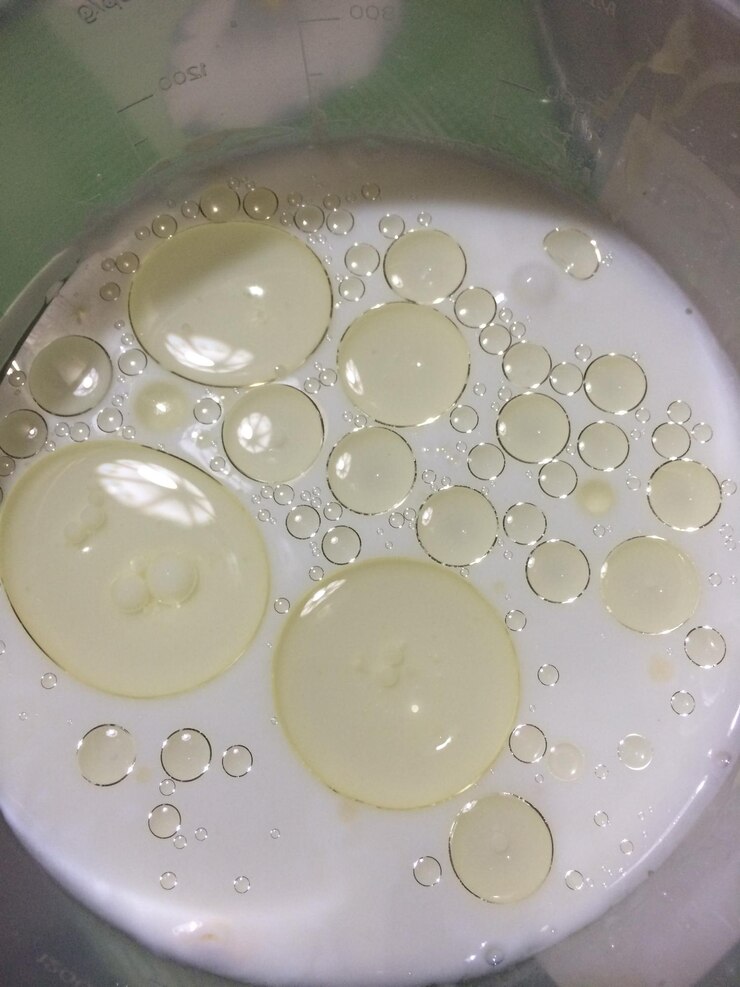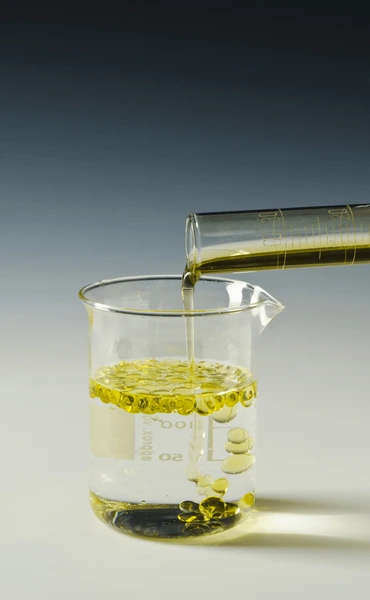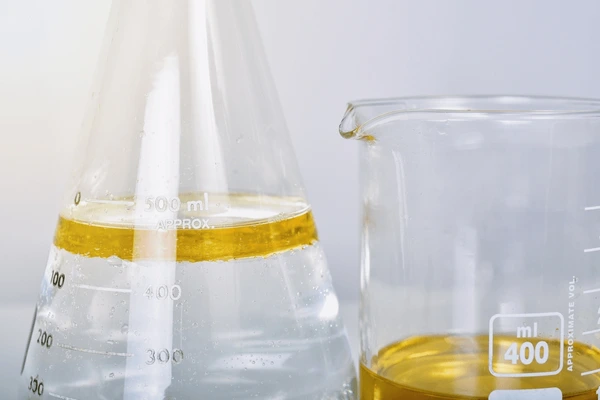Understanding how liquids behave when they are combined is essential. The distinction between miscible and immiscible liquids plays a significant role in scientific research, industrial processes, and daily life. This article explores the definitions, characteristics, and real-world examples of miscible and immiscible liquids, offering a comprehensive overview of how these liquids interact and the reasons behind their behavior.
What are Miscible Liquids?

Miscible liquids are liquids that mix in all proportions, forming a homogeneous solution. When two miscible liquids are combined, their molecules intermix completely, leading to a single-phase liquid without any visible separation.
This uniformity in the mixture occurs because the intermolecular forces between the different liquid molecules are similar or compatible enough to allow for seamless integration. In simpler terms, the molecules attract each other strongly enough to remain mixed.
Key Characteristics of Miscible Liquids
- They form a uniform composition throughout the solution.
- No phase boundary is observed.
- They do not separate over time.
- The mixture appears as a single liquid phase.
Examples of Miscible Liquids
- Water and Ethanol: Common in laboratories and alcoholic beverages, these two mix perfectly due to hydrogen bonding.
- Acetone and Water: Widely used in cleaning and solvent applications.
- Vinegar and Water: Vinegar (acetic acid in water) is easily diluted in water.
- Glycerin and Water: Glycerin is often used in pharmaceuticals and cosmetics, and it blends smoothly with water.
What are Immiscible Liquids?

Immiscible liquids, on the other hand, are liquids that do not mix completely, forming two or more distinct layers when combined. This occurs when the intermolecular forces between the liquids are too different, preventing them from blending into a single phase.
These liquids separate into layers based on their density and polarity. The less-dense liquid typically floats on top, while the denser one settles at the bottom.
Key Characteristics of Immiscible Liquids
- They form a heterogeneous mixture.
- Two or more separate layers are visible.
- They do not dissolve into one another.
- Over time, they will remain distinct and separate, unless an emulsifying agent is used.
Examples of Immiscible Liquids
- Oil and Water: A classic example where oil floats on water due to differences in polarity and density.
- Kerosene and Water: Often seen in fuel and industrial applications.
- Mercury and Water: Mercury, being a heavy metal, remains at the bottom and doesn’t mix with water.
- Benzene and Water: Due to the non-polar benzene and polar water, these remain separate.
The Science Behind Miscibility

To understand why some liquids are miscible and others are not, we must consider the concept of polarity and intermolecular forces.
Polarity and Intermolecular Forces
- Polar substances, like water, have molecules with partial charges that attract other polar molecules.
- Non-polar substances, like oils, have molecules without significant charge separation.
“Like dissolves like” is a common rule in chemistry, meaning:
- Polar liquids mix with polar liquids.
- Non-polar liquids mix with non-polar liquids.
When polar and non-polar liquids are combined, they repel each other, leading to immiscibility.
Hydrogen Bonding in Miscible Liquids
Many miscible liquids engage in hydrogen bonding, a strong type of dipole-dipole attraction, which enhances miscibility. For example, ethanol and water both form hydrogen bonds, making them completely miscible.
Practical Applications of Miscibility and Immiscibility

Pharmaceuticals
Formulating oral syrups or injectable solutions requires miscible solvents to ensure active ingredients are uniformly distributed.
Oil Spill Management
Understanding that oil and water are immiscible allows the use of booms and dispersants to clean oil spills effectively.
Cooking and Food Industry
Emulsions like mayonnaise are a mix of immiscible liquids (oil and vinegar), stabilized by an emulsifier like egg yolk.
Perfumes and Cosmetics
The solubility of aromatic compounds in alcohol and water-based solvents depends on their miscibility properties.
How to Determine If Two Liquids Are Miscible or Immiscible
Visual Inspection
Combine equal amounts of the two liquids in a clear container:
- If the mixture appears uniform → miscible.
- If layers are visible → immiscible.
Shake Test
Shake the container and observe:
- If bubbles disappear quickly and no separation occurs → miscible.
- If two layers reform → immiscible.
Solubility Charts and Polarities
Refer to chemical solubility data and polarity charts to predict interactions before actual mixing.
Emulsions: When Immiscible Liquids Are Forced to Mix
Sometimes, two immiscible liquids can be mixed temporarily or permanently using emulsifying agents, creating an emulsion.
Types of Emulsions

- Oil-in-water (O/W): Oil droplets dispersed in water (e.g., milk).
- Water-in-oil (W/O): Water droplets in oil (e.g., butter).
Emulsifiers
Substances like lecithin, soaps, and detergents stabilize the mixture by reducing surface tension and preventing separation.
Difference between Miscible and Immiscible Liquids
| Property | Miscible Liquids | Immiscible Liquids |
|---|---|---|
| Appearance after Mixing | Yes, if a stable mixture is desired | Separate layers |
| Intermolecular Forces | Similar or compatible | Different or incompatible |
| Example Pairs | Water + Ethanol, Acetone + Water | Oil + Water, Mercury + Water |
| Need for Emulsifier | No | Yes, if a stable mixture is desired |
| Polarity | Similar | Dissimilar |
Factors Affecting Miscibility
Temperature
Increasing temperature often increases kinetic energy, promoting miscibility in some cases.
Pressure
Primarily affects gases but can slightly impact the miscibility of some liquids under extreme conditions.
Molecular Size and Structure
Large and complex molecules may hinder miscibility even when polarities match.
Miscibility in Environmental Science
The concept plays a pivotal role in understanding the distribution of pollutants, particularly when dealing with organic solvents in aquatic environments. Proper understanding helps in designing waste treatment systems and environmental remediation plans.
Laboratory Techniques to Test Miscibility
- Mixing Test: Combine equal parts of each liquid and observe.
- Refractive Index Measurement: A uniform index indicates miscibility.
- Spectroscopy: To analyze the homogeneity of the mixture.
Conclusion
Grasping the difference between miscible and immiscible liquids is crucial across various fields, including chemistry, biology, engineering, and even culinary arts. Whether you’re blending liquids in a laboratory, kitchen, or industrial setting, understanding how they interact can help you save time, achieve better outcomes, and maintain safety.
What are Immiscible and Miscible Liquids with examples?
In the vast world of chemistry, the behavior of liquids when mixed is a crucial concept. Understanding the difference between miscible and immiscible liquids can help in various scientific, industrial, and everyday applications. In this article, we dive deep into the definitions, properties, and examples of miscible and immiscible liquids, giving you a detailed overview of how they interact and why.
What are Miscible Liquids?
Miscible liquids are liquids that mix in all proportions, forming a homogeneous solution. When two miscible liquids are combined, their molecules intermix completely, leading to a single-phase liquid without any visible separation.
This uniformity in the mixture occurs because the intermolecular forces between the different liquid molecules are similar or compatible enough to allow for seamless integration. In simpler terms, the molecules attract each other strongly enough to remain mixed.
Key Characteristics of Miscible Liquids
They form a uniform composition throughout the solution.
No phase boundary is observed.
They do not separate over time.
The mixture appears as a single liquid phase.
Examples of Miscible Liquids
Water and Ethanol: Common in laboratories and alcoholic beverages, these two mix perfectly due to hydrogen bonding.
Acetone and Water: Widely used in cleaning and solvent applications.
Vinegar and Water: Vinegar (acetic acid in water) is easily diluted in water.
Glycerin and Water: Glycerin is often used in pharmaceuticals and cosmetics, and it blends smoothly with water.
What are Immiscible Liquids?
Immiscible liquids, on the other hand, are liquids that do not mix completely, forming two or more distinct layers when combined. This occurs when the intermolecular forces between the liquids are too different, preventing them from blending into a single phase.
These liquids separate into layers based on their density and polarity. The less-dense liquid typically floats on top, while the denser one settles at the bottom.
Key Characteristics of Immiscible Liquids
They form a heterogeneous mixture.
Two or more separate layers are visible.
They do not dissolve into one another.
Over time, they will remain distinct and separate, unless an emulsifying agent is used.
Examples of Immiscible Liquids
Oil and Water: A classic example where oil floats on water due to differences in polarity and density.
Kerosene and Water: Often seen in fuel and industrial applications.
Mercury and Water: Mercury, being a heavy metal, remains at the bottom and doesn’t mix with water.
Benzene and Water: Due to non-polar benzene and polar water, these remain separate.
Miscible and Immiscible Liquids
The Science Behind Miscibility
To understand why some liquids are miscible and others are not, we must consider the concept of polarity and intermolecular forces.
Polarity and Intermolecular Forces
Polar substances, like water, have molecules with partial charges that attract other polar molecules.
Miscible and Immiscible Liquids
Non-polar substances, like oils, have molecules without significant charge separation.
“Like dissolves like” is a common rule in chemistry, meaning:
Polar liquids mix with polar liquids.
Non-polar liquids mix with non-polar liquids.
When polar and non-polar liquids are combined, they repel each other, leading to immiscibility.
Hydrogen Bonding in Miscible Liquids
Many miscible liquids engage in hydrogen bonding, a strong type of dipole-dipole attraction, which enhances miscibility. For example, ethanol and water both form hydrogen bonds, making them completely miscible.
Practical Applications of Miscibility and Immiscibility
Pharmaceuticals, Miscible and Immiscible Liquids
Formulating oral syrups or injectable solutions requires miscible solvents to ensure active ingredients are uniformly distributed.
Oil Spill Management
Understanding that oil and water are immiscible allows the use of booms and dispersants to clean oil spills effectively.
Cooking and Food Industry
Emulsions like mayonnaise are a mix of immiscible liquids (oil and vinegar), stabilized by an emulsifier like egg yolk.
Perfumes and Cosmetics
The solubility of aromatic compounds in alcohol and water-based solvents depends on their miscibility properties.
How to Determine If Two Liquids Are Miscible or Immiscible
Visual Inspection
Combine equal amounts of the two liquids in a clear container:
If the mixture appears uniform → miscible.
If layers are visible → immiscible.
Shake Test
Shake the container and observe:
If bubbles disappear quickly and no separation occurs → miscible.
If two layers reform → immiscible.
Solubility Charts and Polarities
Refer to chemical solubility data and polarity charts to predict interactions before actual mixing.
Emulsions: When Immiscible Liquids Are Forced to Mix
Sometimes, two immiscible liquids can be mixed temporarily or permanently using emulsifying agents, creating an emulsion.
Types of Emulsions
Oil-in-water (O/W): Oil droplets dispersed in water (e.g., milk).
Water-in-oil (W/O): Water droplets in oil (e.g., butter).
Emulsifiers: Miscible and Immiscible Liquids
Substances like lecithin, soaps, and detergents stabilize the mixture by reducing surface tension and preventing separation.
Difference between Miscible and Immiscible Liquids
| Property | Miscible Liquids | Immiscible Liquids |
|---|---|---|
| Appearance after Mixing | Yes, if a stable mixture is desired | Separate layers |
| Intermolecular Forces | Similar or compatible | Different or incompatible |
| Example Pairs | Water + Ethanol, Acetone + Water | Oil + Water, Mercury + Water |
| Need for Emulsifier | No | Yes, if a stable mixture is desired |
| Polarity | Similar | Dissimilar |
Miscible and Immiscible Liquids
Factors Affecting Miscibility
Temperature: Miscible and Immiscible Liquids
Increasing temperature often increases kinetic energy, promoting miscibility in some cases.
Pressure: Miscible and Immiscible Liquids
Primarily affects gases but can slightly impact the miscibility of some liquids under extreme conditions.
Molecular Size and Structure: Miscible and Immiscible Liquids
Large and complex molecules may hinder miscibility even when polarities match.
Miscibility in Environmental Science: Miscible and Immiscible Liquids
Miscible and Immiscible Liquids
The concept plays a pivotal role in understanding the distribution of pollutants, particularly when dealing with organic solvents in aquatic environments. Proper understanding helps in designing waste treatment systems and environmental remediation plans.
Laboratory Techniques to Test Miscibility: Miscible and Immiscible Liquids
Mixing Test: Combine equal parts of each liquid and observe.
Refractive Index Measurement: A uniform index indicates miscibility.
Spectroscopy: To analyze the homogeneity of the mixture.
Conclusion
Grasping the difference between miscible and immiscible liquids is crucial across various fields, including chemistry, biology, engineering, and even culinary arts. Whether you’re blending liquids in a laboratory, kitchen, or industrial setting, understanding how they interact can help you save time, achieve better outcomes, and maintain safety.
Can two immiscible liquids become miscible with heat?
Miscible and Immiscible Liquids
Why is oil immiscible with water?
Miscible and Immiscible Liquids
Is alcohol miscible with water?
Miscible and Immiscible Liquids
What is partial miscibility?
What is the difference between immiscible and miscible liquids?
| Property | Miscible Liquids | Immiscible Liquids |
|---|---|---|
| Appearance after Mixing | Yes, if a stable mixture is desired | Separate layers |
| Intermolecular Forces | Similar or compatible | Different or incompatible |
| Example Pairs | Water + Ethanol, Acetone + Water | Oil + Water, Mercury + Water |
| Need for Emulsifier | No | Yes, if a stable mixture is desired |
| Polarity | Similar | Dissimilar |
Miscible and Immiscible Liquids
Miscible and Immiscible Liquids
Explain the differences between miscible and immiscible liquids.
In the vast world of chemistry, the behavior of liquids when mixed is a crucial concept. Understanding the difference between miscible and immiscible liquids can help in various scientific, industrial, and everyday applications. In this article, we dive deep into the definitions, properties, and examples of miscible and immiscible liquids, giving you a detailed overview of how they interact and why.
What are Miscible Liquids?
Miscible liquids are liquids that mix in all proportions, forming a homogeneous solution. When two miscible liquids are combined, their molecules intermix completely, leading to a single-phase liquid without any visible separation.
This uniformity in the mixture occurs because the intermolecular forces between the different liquid molecules are similar or compatible enough to allow for seamless integration. In simpler terms, the molecules attract each other strongly enough to remain mixed.
Key Characteristics of Miscible Liquids
They form a uniform composition throughout the solution.
No phase boundary is observed.
They do not separate over time.
The mixture appears as a single liquid phase.
Examples of Miscible Liquids
Water and Ethanol: Common in laboratories and alcoholic beverages, these two mix perfectly due to hydrogen bonding.
Acetone and Water: Widely used in cleaning and solvent applications.
Vinegar and Water: Vinegar (acetic acid in water) is easily diluted in water.
Glycerin and Water: Glycerin is often used in pharmaceuticals and cosmetics, and it blends smoothly with water.
What are Immiscible Liquids?
Immiscible liquids, on the other hand, are liquids that do not mix completely, forming two or more distinct layers when combined. This occurs when the intermolecular forces between the liquids are too different, preventing them from blending into a single phase.
These liquids separate into layers based on their density and polarity. The less-dense liquid typically floats on top, while the denser one settles at the bottom.
Key Characteristics of Immiscible Liquids
They form a heterogeneous mixture.
Two or more separate layers are visible.
They do not dissolve into one another.
Over time, they will remain distinct and separate, unless an emulsifying agent is used.
Examples of Immiscible Liquids
Oil and Water: A classic example where oil floats on water due to differences in polarity and density.
Kerosene and Water: Often seen in fuel and industrial applications.
Mercury and Water: Mercury, being a heavy metal, remains at the bottom and doesn’t mix with water.
Benzene and Water: Due to non-polar benzene and polar water, these remain separate.
The Science Behind Miscibility
To understand why some liquids are miscible and others are not, we must consider the concept of polarity and intermolecular forces.
Polarity and Intermolecular Forces
Polar substances, like water, have molecules with partial charges that attract other polar molecules.
Non-polar substances, like oils, have molecules without significant charge separation.
“Like dissolves like” is a common rule in chemistry, meaning:
Polar liquids mix with polar liquids.
Non-polar liquids mix with non-polar liquids.
When polar and non-polar liquids are combined, they repel each other, leading to immiscibility.
Hydrogen Bonding in Miscible Liquids
Many miscible liquids engage in hydrogen bonding, a strong type of dipole-dipole attraction, which enhances miscibility. For example, ethanol and water both form hydrogen bonds, making them completely miscible.
Practical Applications of Miscibility and Immiscibility
Pharmaceuticals
Formulating oral syrups or injectable solutions requires miscible solvents to ensure active ingredients are uniformly distributed.
Oil Spill Management
Understanding that oil and water are immiscible allows the use of booms and dispersants to clean oil spills effectively.
Cooking and Food Industry
Emulsions like mayonnaise are a mix of immiscible liquids (oil and vinegar), stabilized by an emulsifier like egg yolk.
Perfumes and Cosmetics
The solubility of aromatic compounds in alcohol and water-based solvents depends on their miscibility properties.
How to Determine If Two Liquids Are Miscible or Immiscible
Visual Inspection
Combine equal amounts of the two liquids in a clear container:
If the mixture appears uniform → miscible.
If layers are visible → immiscible.
Shake Test
Shake the container and observe:
If bubbles disappear quickly and no separation occurs → miscible.
If two layers reform → immiscible.
Solubility Charts and Polarities
Refer to chemical solubility data and polarity charts to predict interactions before actual mixing.
Emulsions: When Immiscible Liquids Are Forced to Mix
Sometimes, two immiscible liquids can be mixed temporarily or permanently using emulsifying agents, creating an emulsion.
Types of Emulsions
Oil-in-water (O/W): Oil droplets dispersed in water (e.g., milk).
Water-in-oil (W/O): Water droplets in oil (e.g., butter).
Emulsifiers
Substances like lecithin, soaps, and detergents stabilize the mixture by reducing surface tension and preventing separation.
Difference between Miscible and Immiscible Liquids
| Property | Miscible Liquids | Immiscible Liquids |
|---|---|---|
| Appearance after Mixing | Yes, if a stable mixture is desired | Separate layers |
| Intermolecular Forces | Similar or compatible | Different or incompatible |
| Example Pairs | Water + Ethanol, Acetone + Water | Oil + Water, Mercury + Water |
| Need for Emulsifier | No | Yes, if a stable mixture is desired |
| Polarity | Similar | Dissimilar |
Temperature
Increasing temperature often increases kinetic energy, promoting miscibility in some cases.
Pressure
Primarily affects gases but can slightly impact the miscibility of some liquids under extreme conditions.
Molecular Size and Structure
Large and complex molecules may hinder miscibility even when polarities match.
Miscibility in Environmental Science
The concept plays a pivotal role in understanding the distribution of pollutants, particularly when dealing with organic solvents in aquatic environments. Proper understanding helps in designing waste treatment systems and environmental remediation plans.
Laboratory Techniques to Test Miscibility
Mixing Test: Combine equal parts of each liquid and observe.
Refractive Index Measurement: A uniform index indicates miscibility.
Spectroscopy: To analyze the homogeneity of the mixture.
Conclusion
Grasping the difference between miscible and immiscible liquids is crucial across various fields, including chemistry, biology, engineering, and even culinary arts. Whether you’re blending liquids in a laboratory, kitchen, or industrial setting, understanding how they interact can help you save time, achieve better outcomes, and maintain safety.
